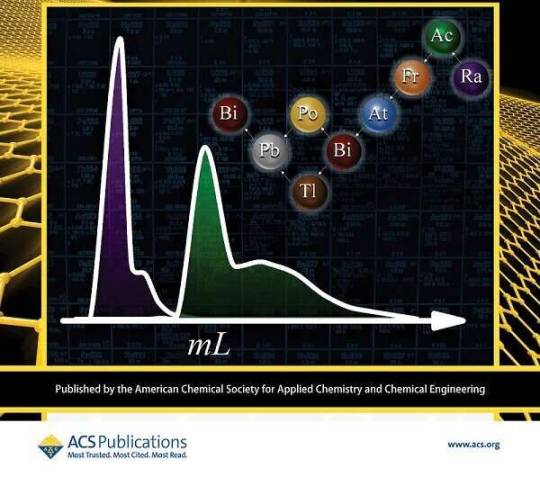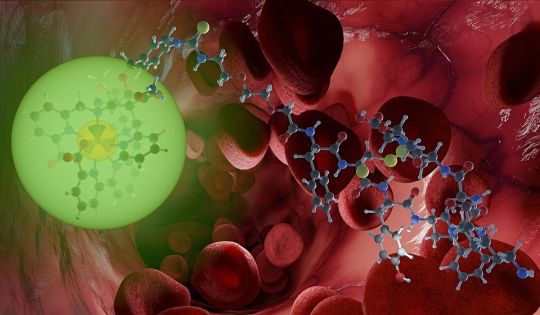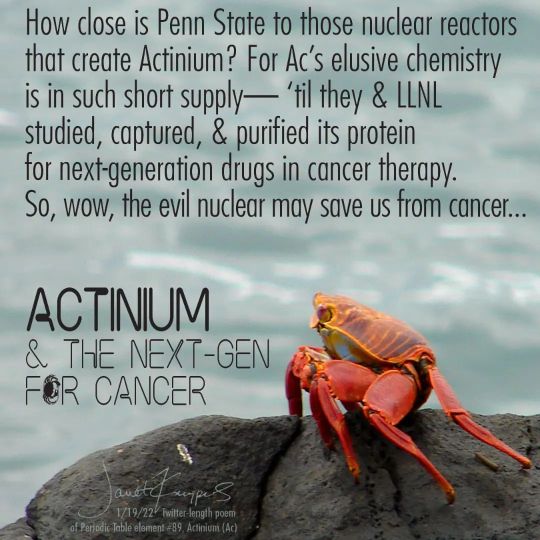#actinium therapy
Link
Best PRRT Therapy Centre for Neuroendocrine Tumours in India. To know more about what is PRRT, how it`s performed, benefits & its side-effects visit nuclearmedicinetherapy.in.
#actinium 225 cancer treatment#actinium therapy#peptide receptor radionuclide therapy#prrt#prrt in neuroendocrine tumors#prrt therapy side effects#prrt treatment#prrt treatment cost in india#prrt treatment for neuroendocrine tumors#Alpha PRRT in India#Ac 225 Therapy in India#Actinium Ac 225 Alpha PRRT#Actinium Therapy in India#Actinium 225 Therapy in India#PRRT in India#PRRT Treatment in India#PRRT Therapy
0 notes
Text

Scientists develop inorganic resins for generating and purifying radium and actinium
Targeted alpha therapy can destroy cancerous cells without harming healthy cells. It's especially useful for treating metastasized cancers. The Department of Energy (DOE) Office of Science's Isotope Program is developing and marketing novel radioactive isotopes for targeted alpha therapy.
One method of making one isotope, actinium-225, involves bombarding radium targets with neutrons. This method poses a challenge: how to chemically separate the radium from the actinium. This can destroy typical separation equipment due to a radioactive process called alpha decay. Now, researchers have investigated the use of radiation-resistant inorganic resin scaffolds as platforms for separating radium, actinium, and lead.
Demand and production of actinium-225 (Ac-225) and other alpha-emitting radioisotopes are increasing. These new types of resins will support the purification and distribution of these lifesaving isotopes. As production increases, radiation levels will also increase. Chemical processes need to be robust in these hazardous environments. These new resins and this recent research will help producers save time, effort, and costs while reducing the risks of manufacturing alpha-emitting radioisotopes.
Read more.
7 notes
·
View notes
Text

Clinical trials are also underway for PSMA-targeted therapy with alpha-emitting radionuclides. Alpha particles are much more energetic and thus cause more localized damage than beta particles. They do not travel as far in tissue, so they tend to have less toxicity. Image shows a patient with metastatic prostate cancer who had excellent response after 2 cycles of actinium-225-PSMA targeted alpha therapy (TAT). Reference: Zacherl et al. J. Nucl. Med. 2021, 62, 669-674.
#TeachingRounds#FOAMed#FOAMRad#Radiology#NuclearMedicine#PETCT
#Theransotics#NucMed#PSMA#radioligandtherapy#urology#oncology#alphatherapy
#TeachingRounds#FOAMed#FOAMRad#Radiology#NuclearMedicine#PETCT#Theransotics#NucMed#PSMA#radioligandtherapy#urology#oncology#alphatherapy
6 notes
·
View notes
Text
Actinium Pharmaceuticals Inc (ATNM) Targets Breakthrough in Cancer Therapy: Proprietary Production of Vital Isotope Sparks Industry Buzz and Share Surge
http://dlvr.it/T4P52f
0 notes
Text
Actinium Pharmaceuticals Inc (ATNM) Targets Breakthrough in Cancer Therapy: Proprietary Production of Vital Isotope Sparks Industry Buzz and Share Surge
http://dlvr.it/T4P4cL
0 notes
Text
How is radioligand therapy developed?
In the changing dynamics of medical science, innovations are the hope for people fighting life-threatening illnesses. Radioligand treatment, commonly denoted to as targeted radionuclide treatment, is one such pioneering method that has been generating waves in the field of oncology. While the name may sound multifaceted, the concept is quite attractive, providing a promising avenue for cancer treatment.
The radioligand therapy market is experiencing growth and is projected to reach USD 13,073.9 million by 2030.

Understanding the Basics
Radioligand treatment includes the utilization of dedicated molecules, called radioligands, which are made to target specific receptors on cancer cells. Such radioligands are fortified with a radioactive isotope, like actinium-225 or lutetium-177. When directed into the patient's body, such radioligands seek out and assign themselves to the receptors on cancer cells, providing a powerful dose of radiation straight to the tumor.
Exactness and Minimalized Side Effects
One of the major benefits of radioligand treatment is its accuracy. Not like conservative radiation treatment, which can affect healthy tissues covering the tumor, radioligand treatment selectively targets cancer cells. This targeted method not only increases the efficiency of treatment but also reduces the harm to healthy tissue, decreasing the danger of side effects.
Prostate Cancer Treatment
Prostate cancer is one of the zones where radioligand treatment has revealed marvelous potential. The FDA sanction of treatments such as Lutathera® for neuroendocrine Xofigo® and tumors for metastatic castration-resistant prostate cancer establishes the rising recognition of radioligand therapy's potential.
The Patient Experience
For patients, radioligand treatment can be the only hope in a complex diagnosis. The treatment is generally managed as an outpatient process, permitting patients to back to their everyday lives comparatively rapidly. Although there might be some side effects, like nausea or fatigue, they are typically wieldy and temporary.
Ongoing Research and Growth
The arena of radioligand treatment is constantly changing. Investigators are discovering new radioligands and radioisotopes, directing to increase the variety of cancers that can be efficiently treated using this method. Clinical trials are ongoing, providing patients the chance to access pioneering treatments.
Challenges
While radioligand treatment has great potential, it is not without challenges. Obtainability and price can be fences for some patients. Moreover, the logistics of managing radioactive materials need particular amenities and expertise.
The U.S. Is Principal Contributor to Market
The market for radioligand therapy in the U.S. will witness a high growth rate during the forecast period. The growth is attributed to the government initiatives for improving chronic disease care and the rising number of specialized cancer hospitals and research centers. For instance, in February 2022, the U.S. president reinvigorated the Cancer Moonshot Program with new goals, to reduce the death rate from cancer by at least 50% over the next 25 years. Thus, the rising number of government initiatives for advancing oncologic practices augments the market for radioligand therapy in the U.S.
0 notes
Text
Global Alpha Emitter Market is Estimated To Witness High Growth Owing To Increasing Applications in Cancer Treatment

The global Alpha Emitter market is estimated to be valued at US$ 1,331.0 million in 2023 and is expected to exhibit a CAGR of 10.3% over the forecast period 2023-2030, as highlighted in a new report published by Coherent Market Insights.
A) Market Overview:
The alpha emitter market refers to the use of radioactive isotopes that emit alpha particles for various applications, particularly in cancer treatment. These isotopes are highly effective in targeting and destroying cancer cells while minimizing damage to surrounding healthy tissues. Alpha emitters offer several advantages over other treatment modalities, such as less toxicity and shorter treatment duration. The need for more precise and targeted cancer therapies has led to the increasing demand for alpha emitter-based treatments.
B) Market Key Trends:
One key trend in the alpha emitter market is the growing adoption of targeted alpha therapy (TAT). TAT involves the use of alpha emitters coupled with tumor-targeting molecules, such as antibodies or peptides, to specifically deliver the radiation dose to cancer cells. This approach offers several advantages, including enhanced tumor cell killing, reduced systemic toxicity, and increased precision in tumor targeting. For example, Actinium Pharmaceutical Inc. has developed Iomab-B, a TAT targeting CD45 antigens on leukemia cells, which has shown promising results in clinical trials.
C) PEST Analysis:
Political: The use of radioactive materials in medical applications requires strict regulatory compliance to ensure safety and minimize potential risks.
Economic: The growing prevalence of cancer globally and the increasing demand for more effective treatments are driving market growth.
Social: The rising awareness about cancer and the need for targeted therapies among patients and healthcare professionals are contributing to market growth.
Technological: Advances in radiopharmaceuticals and imaging techniques are facilitating the development and adoption of alpha emitter-based therapies.
D) Key Takeaways:
- The global alpha emitter market[AK1] is expected to witness high growth, exhibiting a CAGR of 10.3% over the forecast period, due to increasing demand for more precise and targeted cancer treatments.
- North America is the fastest-growing and dominating region in the alpha emitter market, fueled by the presence of key players, well-established healthcare infrastructure, and high investment in research and development.
- Key players operating in the global alpha emitter market include Actinium Pharmaceutical Inc., Alpha Tau Medical Ltd, Bayer AG, Bracco, Cardinal Health, Eckert & Ziegle, Fusion Pharmaceuticals, IBA Worldwide, NorthStar Medical Radioisotopes (NMR), Orano Group, Viewpoint Molecular Targeting, RadioMedix, Telix Pharmaceuticals Limited, TerraPower, LLC, NIOWAVE Inc., and IONETIX Corporation.
In conclusion, the global alpha emitter market is experiencing significant growth due to the increasing demand for more precise and targeted cancer therapies. The adoption of targeted alpha therapy, coupled with advancements in radiopharmaceuticals and imaging techniques, is driving market growth. North America is the fastest-growing region, supported by key players and robust healthcare infrastructure. The key players in the market are actively involved in research and development to further enhance the efficacy and safety of alpha emitter-based treatments.
[AK1]
#Coherent Market insights#Healthcare#Healthcare Industry#Pharmaceutical#Alpha Emitter#Alpha Emitter Market
0 notes
Text
Research team develops new system for imaging and treating tumors

Research team develops a new system for imaging and treating tumors.
May 26, 2023 - Thanks to the radiation they emit, radioactive compounds are suited both to imaging and treating cancers. By appropriately combining them in the novel, so-called radionuclide theranostics, both applications can be dovetailed. A radiopharmacy team at Helmholtz-Zentrum Dresden-Rossendorf (HZDR) and Heidelberg University has now presented such a system in the Journal of the American Chemical Society (DOI: 10.1021/jacs.2c08438) that successfully solves one of the biggest problems to date: it works at physiologically relevant temperatures.
“Basically, we can think of it as functioning like a smart key that we use to control our automobiles. We use so-called radionuclides, i.e., unstable atomic nuclei, that spontaneously emit ionized radiation when they decay. We track down the tumor with a diagnostic radionuclide. The targeted internal irradiation close to the diseased tissue is then taken on by a different, therapeutic radionuclide,”
says Dr. Manja Kubeil of HZDR’s Institute of Radiopharmaceutical Cancer Research, describing her theranostic approach.
Her team in the Department of Radionuclide Theragnostics develops exactly these types of substances to track and destroy tumors. Thus, the researchers employ matched pairs of radionuclides which, due to their decomposition characteristics, can be used both for imaging and for tumor therapy on the same target molecule.
The relevant radionuclide is stably bound in what is known as a chelator and linked to a biomolecule by a kind of chemical bridge.
“The word chelator comes from the Latin; its stem relates to being encircled by the claws of a crayfish. We prefer the image of a molecular cage that firmly encloses the radionuclide so that it can’t spread in the body uncontrollably. The target-seeking biomolecule for its part must fit perfectly with the docking site on the cancer cells, just like a key in a lock. The radionuclide then accumulates on the tumor tissue and exclusively develops its destructive impact there – that’s the idea,”
says Kubeil
Stable bonds at practicable temperatures
Lutetium-177, for instance, is particularly suitable as a beta emitter for releasing electrons to treat various tumors as well as a source of gamma rays for imaging. Actinium-225, an alpha emitter that can be used for efficient treatment, is even more effective in destroying tumors and is also very tightly bound by the chelator. Neither radionuclide occurs naturally on Earth. Appropriate methods have to be used to produce them artificially.
Alpha emitters release particles composed of two protons and two neutrons. They are used in cancer therapy because their range in the tissue is very small, but they nonetheless attack and kill cancer cells very effectively thanks to their high energy. Their half-life of seven days in the case of Lutetium-177 and ten in the case of Actinium-225 is ideal for the purpose: it is long enough to enable effective treatment.
New chelator with advantages
So far, there has only been one complexing agent on the market that binds both radionuclides equally well: DOTA. The most frequently used chelator in nuclear medicine is known for its very stable metal complexes. But DOTA has one big disadvantage: only at what are very high temperatures for biochemical conditions, beyond 80 degrees Celsius, is it possible to bond theranostic radionuclides completely.
“If you are working with protein derivatives, these temperatures are way too high because even at 40 degrees Celsius denaturation kicks in: they are destroyed. Our new chelator system functions reliably at these lower temperatures,”
Kubeil is pleased to report.
Moreover, under these milder conditions, it achieves faster radiolabeling than the known chelators. Another advantage is that the new system efficiently attaches to various bioconjugates. This means an increase in the choice of docking sites on diseased tissue. The newly developed chelator could thus form the basis for new modular and personalized pharmaceutical systems that could be geared towards different fields for imaging and therapy by simply exchanging partial chemical structures.
Publication:
P. Cieslik, M. Kubeil, K. Zarschler, M. Ullrich, F. Brandt, K. Anger, H. Wadepohl, K. Kopka, M. Bachmann, J. Pietzsch, H. Stephan, P. Comba, Toward Personalized Medicine: One Chelator for Imaging and Therapy with Lutetium-177 and Actinium-225, Journal of the American Chemical Society, 2022 (DOI: 10.1021/jacs.2c08438)
Read the full article
1 note
·
View note
Text

Lutetium-177 PSMA therapy is a new, cutting-edge treatment for prostate cancer that is showing great promise. This therapy uses a radioactive isotope called lutetium-177, which targets and kills cancer cells while sparing healthy tissue. Lutetium-177 PSMA therapy is currently being used in clinical trials and has been shown to be effective in treating prostate cancer. This treatment is non-invasive just like Actinium (Ac225) PSMA Therapy and has very few side effects, making it an attractive option for patients with this disease.
TAG- Outcome of Lu177 PSMA Therapy in India, Cost of Lutetium or Lu177 PSMA Therapy in India
0 notes
Link
Find the best Actinium Ac225 Alpha PRRT Treatment for Neuroendocrine Tumors in India only at Nuclear Medicine Therapy. Targeted alpha PRRT has the potential to overcome many of the limitations of conventional Lu177 PRRT.
#actinium 225 cancer treatment#actinium therapy#peptide receptor radionuclide therapy#prrt#prrt in neuroendocrine tumors#prrt therapy side effects#prrt treatment prrt treatment cost in india#prrt treatment for neuroendocrine tumors#Alpha PRRT in India Ac 225 Therapy in India#Actinium Ac 225 Alpha PRRT#Actinium Therapy in India#Actinium 225 Therapy in India#PRRT in India#PRRT Treatment in India#PRRT Therapy
0 notes
Photo

Thorium-228 supply ripe for research into medical applications
As a medical isotope, thorium-228 has a lot of potential—and Oak Ridge National Laboratory produces a lot.
That's one reason ORNL researchers are especially excited about studies looking at different medical applications for the radioisotope. ORNL produces large quantities of Th-228 for the Department of Energy's Isotope Program as a byproduct of actinium-227 production.
Both Ac-227 and Th-228 are created when ORNL irradiates radium-226 in the High Flux Isotope Reactor. Maximizing the production of Ac-227, used in cancer treatments, is the goal, but the process also produces a significant amount of Th-228.
Th-228 is used to make radium-224/lead-212 generators. These generators allow the radium-224 extracted from Th-228 to decay over time and produce lead-212 and bismuth-212 for research on targeted alpha therapy, attacking metastatic skin cancers and neuroendocrine tumors with minimal damage to surrounding tissue.
Read more.
31 notes
·
View notes
Text
1.516. Tag - 05. Februar 2021
So, hier jetzt ein kurzer medizinischer Exkurs zu der Therapie, der ich mich hier aussetze. Seit einigen Jahren wird Lutetium-177 zur Therapie gegen neuroendokrine Tumore wie beispielsweise in der Prostata oder Bauchspeicheldrüse eingesetzt. Dazu wird Lu-177 an ein Eiweißmolekül, eine so genannte Fähre, gekoppelt und gelangt damit direkt in den Tumor. Lu-177 ist ein Betastrahler (Beta-Minus-Zerfall: Aussendung eines Elektrons und eines Elektron-Antineutrinos) mit der sehr geringen Reichweite von etwa zwei Millimeter, was bedeutet, dass das gesunde Gewebe praktisch nicht geschädigt wird. Die 225Actinium-PSMA-Therapie ist eine noch neuartigere, aber vielversprechende Therapie für das metastasierte, kastrationsresistente Prostatakarzinom. Sie ist vor allem für Patienten gedacht, die nach bereits erfolgter Lutetium-177-PSMA-Therapie ein fortschreiten der Tumorerkrankung aufweisen. Das Prinzip der Therapie basiert darauf, dass ein therapeutisch wirksamer Strahler (Actinium-225) an eine spezielle Spürsubstanz gebunden wird, die diesen Strahler gezielt zu den Tumorzellen des Prostatakarzinoms trägt, dort bindet und in die Zellen aufgenommen wird. Durch die lokale Bestrahlung kommt es dann zur selektiven Zerstörung der Tumorzellen bei weitgehender Schonung des umliegenden Gewebes. Die Spürsubstanz bindet dabei an das sogenannte Prostata-spezifische Membranantigen (PSMA), welches um ein vielfaches höher auf Zellen des Prostatakarzinoms und seiner Metastasen vorkommt. Dieser Bindungsmechanismus wird bereits sehr erfolgreich in der PSMA PET-CT-Diagnostik und bei der 177Lutetium-PSMA-Therapie genutzt. Die 225Actinium-PSMA-Therapie ist noch nicht zugelassen und wurde bisher nur an einer kleinen Anzahl von Patienten durchgeführt. Insbesondere das Nebenwirkungsprofil ist noch nicht umfassend bekannt. Die bis jetzt festgestellten signifikanten Nebenwirkungen sind: Einschränkung der Speicheldrüsenfunktion; Auswirkungen auf das Blutsystem und Einschränkung der Nierenfunktion. Im Vergleich zu der bereits durchgeführten 177Lutetium-PSMA-Liganden-Therapie, die eine Behandlung mit beta-Strahlern darstellt, handelt es sich hierbei um die Gabe einer mit einem radioaktiven alpha-Strahler markierten Substanz. Hierbei handelt es sich um einen höher energetischen Strahler, welcher eine höhere Rate von Doppelstrangbrüchen in den Tumorzellen hervorrufen kann und somit zum Zelltod der Tumorzelle führt. Ein weiterer Vorteil ist die kürzere Reichweite von lediglich ca. 0,04 mm, was eine Schonung des umgebenden Gewebes bedeutet. Die 225Actinium-PSMA-Therapie wird im Rahmen einer individuellen Heilmaßnahme während eines kurzen stationären Aufenthalts durchgeführt. Das soll erst einmal reichen. Heute geht es mir leider überhaupt nicht gut. Vielleicht ist dieses Actinium-225 doch ziemlich hart und verursacht eben ziemlich starke Knochenschmerzen. Keine Ahnung. Aber da muss ich durch. Jetzt steht die Ganzkörperszintigrafie an, vor der ich ziemlich großen Respekt habe. Man hat da das Gefühl, dass einem ein großer und sehr schwerer Granit-Block direkt aufs Gesicht fällt. Ist natürlich nicht so und ich begegne dem, indem ich mir eine Maske über die Augen ziehe. 30 Minuten lang. Da spürt man übrigens im Liegen auch sämtliche Knochen, weil sich dieses dämliche Gehirn nur darauf konzentriert. Ich werde es überstehen, aber mich nie daran gewöhnen. 48 Stunden nach meiner Litetium- und Actinium-Infusion kann ich entlassen werden. Das wäre also 13.00 Uhr am Samstag, dem 06.02.21. Da mache ich wieder 3 ganz große Kreuze. Auch, wenn ich dann erfahren werde, ob, wie und wann es weitergeht. Die Ganzkörperszintigrafie habe ich gegen 12.15 Uhr überstanden und ich muss sagen, es verlief eben nicht so extrem wie es beschrieben habe. Ist eben jedesmal anders und diesmal war es weitestgehend easy. Ich habe auch währenddessen die Schwester zugetextet. Den Ausdruck der Szintigrafie seht ihr hier unten. Deutlich erkennbar in der Vorder-/Rückansicht, dass die Tumorlast zurückgedrängt wurde. Keine Ahnung, ob hier das Actinium 225 schon gewirkt hat. Ich werde nachfragen! Ciao.


Foyer der Zentralklinik Bad Berka. Jawohl, der Pfeil zeigt genau, wo es hingeht. Nämlich „RAUS“ und ab nach Hause - am 06. Februar 2021, 12.45 Uhr.
3 notes
·
View notes
Text
Alpha Emitters Market Key Players, Industry Overview and Forecast 2019-2027
Alpha Emitters Market: Introduction
· Alpha emitters plays important role in the cancer treatment. Properties of alpha emitters have led to exert profound differences between this field and other fields of nuclear medicine. Due to their short range and high LET (deposit energy in unit length of their pathway), alpha particles have remarkably been considered into medical research.
· Alpha emitters are used in the treatment of different types of cancers including ovarian cancer, pancreatic cancer, lymphoma, and melanoma. Various types of radionuclides, such as radium, lead and bismuth, are used in the treatment process.
Report Overview:https://www.transparencymarketresearch.com/alpha-emitters-market.html
Key Drivers of Alpha Emitters Market
· Increase in awareness of the potential benefits of targeted alpha emitter and high number of patients with various types of cancers such as ovarian cancer, pancreatic cancer, lymphoma, and melanoma are likely to boost the growth of market. In addition, increasing use of targeted anticancer or alpha therapy (TAT) in the treatment of cancer and alpha particles has an advantage in targeted therapy because of their exceptionally high cell-killing ability. This helps propel the alpha emitters market.
· According to the National Center for Biotechnology Information (NCBI), in 2018, around 184,799 deaths occurred due to ovarian cancer, accounting for 4.4% of the entire cancer-related mortality among women
· On the other hand, stringent rules and regulations for new product approvals and high expenditure required for research & development activity are likely to restrain the growth of the alpha emitters market
Ovarian Cancer Segment to Dominate Market
· Based on application, the global alpha emitters market can be segmented into ovarian cancer, pancreatic cancer, lymphoma, melanoma, bone metastasis, and others
· The ovarian cancer segment accounted for the highest share of the alpha emitters market in 2018. This segment is expected to dominate the alpha emitters market due to increase in prevalence of ovarian cancer. According to the American Cancer Society, in 2018, around 22,240 women were expected to receive a new diagnosis of ovarian cancer, and about 14,070 women would die from ovarian cancer.
Radium is Most Common Radionuclide Used in Cancer Treatment
· In terms of type of radionuclide, the global alpha emitters market can be divided into radium, bismuth, lead, actinium, and others
· The radium segment generated the highest revenue in 2018 and is anticipated to witness growth during the forecast period. This can be attributed to increase in use of radium in the treatment of cancer.
North America to Dominate Global Alpha Emitters Market
· In terms of region, the global alpha emitters market can be categorized into North America, Europe, Asia Pacific, Latin America, and Middle East & Africa
· North America dominated the global alpha emitters market in 2018 and is expected to maintain its leading position during the forecast period. This dominance of the region can be attributed to increase in incidence of cancer, presence of key market players in the region, and strong product pipeline. According to American Cancer Society, in 2020, about 57,600 people (30,400 men and 27,200 women) are likely to be diagnosed with pancreatic cancer in the U.S. and 47,050 people (24,640 men and 22,410 women) are likely to die of pancreatic cancer in the U.S.
· The market in Asia Pacific is projected to register highest growth during the forecast period, owing to increase in adoption of new products, and rise in incidence of cancer in emerging countries such as India and China
Request For Custom Research:
https://www.transparencymarketresearch.com/sample/sample.php?flag=CR&rep_id=76315
Key Manufacturers Operating in Global Market
The global alpha emitters market was highly fragmented in 2018. Key manufacturers operating in the global market are:
· Bayer AG
· IBA Radiopharma Solution
· Alpha Tau Medical Ltd
· Actinium Pharmaceutical Inc.
· RadioMedix Inc.
Global Alpha Emitters Market: Research Scope
Global Alpha Emitters Market, by Application
· Ovarian Cancer
· Pancreatic Cancer
· Lymphoma
· ��Melanoma
· Bone Metastasis
· Others
Global Alpha Emitters Market, by Type of Radionuclide
· Radium
· Lead
· Bismuth
· Actinium
· Others
Pre Book:
https://www.transparencymarketresearch.com/checkout.php?rep_id=76315<ype=S
More Trending Reports by Transparency Market Research:
https://www.globenewswire.com/news-release/2022/03/22/2407815/0/en/Indwelling-Catheters-Market-to-Exceed-Valuation-of-US-1-6-Bn-by-2027-Says-TMR.html
https://www.globenewswire.com/news-release/2022/04/04/2415739/0/en/Nanotechnology-Drug-Delivery-Market-to-Advance-at-CAGR-of-7-9-During-Forecast-Period-Says-TMR-Study.html
About Us
Transparency Market Research is a global market intelligence company, providing global business information reports and services. Our exclusive blend of quantitative forecasting and trends analysis provides forward-looking insight for thousands of decision makers. Our experienced team of Analysts, Researchers, and Consultants, use proprietary data sources and various tools and techniques to gather, and analyse information. Now avail flexible Research Subscriptions, and access Research multi-format through downloadable databooks, infographics, charts, interactive playbook for data visualization and full reports through MarketNgage, the unified market intelligence engine. Sign Up for a 7 day free trial!
Contact Us
Transparency Market Research,
90 State Street, Suite 700,
Albany, NY 12207
Tel: +1-518-618-1030
USA – Canada Toll Free: 866-552-3453
Email: [email protected]
Website: https://www.transparencymarketresearch.com/
0 notes
Text
ɛəlrtgʌətnəaɪewtsnɑɛə
Pronounced: ayuhlrtguuhtnuhaiewtsnahayuh.
Pantheon of: docility, actinium, extraordinariness, solid, asset, safeness, quality.
Entities
Deiʃvmolvkddzsŋrəənɒ
Pronounced: deishvmolvkddzsngruhuhnou
Solid: cast.
Extraordinariness: uncommonness.
Quality: inferiority.
Asset: advantage.
Legends: schedule feeding, embryonic stem-cell research, expansion.
Relations: ʌnæɑkɛitstnnrzovænəæ (gasoline tax).
Dɑsfəʃəwəubmznnsðiin
Pronounced: dahsfuhshuhwuhubmznnsthiin
Solid: concave shape.
Extraordinariness: uncommonness.
Quality: superiority.
Asset: resource.
Legends: sashay, care, medal play, imprisonment.
Prophecies: worrying, line-drive triple, bond trading, fruitage.
Isɪbsəpsuhɛtteəəmolv
Pronounced: isibsuhpsuhaytteuhuhmolv
Solid: cylinder.
Extraordinariness: uncommonness.
Quality: superiority.
Asset: advantage.
Legends: councillorship, civil defense, counterblast, guerrilla theater, bit part.
Prophecies: moneymaking, curatorship, slip, fusion, spaceflight.
Relations: ɪzwdɪtnendnzdfəeɪɪki (slip), ʌtʃzaɪtbpəɪvʊttrbnzɪwð (darmstadtium).
Iykəlʌsɪilɛbɪlɑrəisə
Pronounced: iykuhlusiilaybilahruhisuh
Solid: polyhedron.
Extraordinariness: uncommonness.
Quality: inferiority.
Asset: advantage.
Legends: filial duty.
Prophecies: musical, major surgery.
Npɪənmtkltdŋnlbənlnaɪ
Pronounced: npiuhnmtkltdngnlbuhnlnai
Solid: toroid.
Extraordinariness: uncommonness.
Quality: superiority.
Asset: resource.
Legends: electrical discharge, atrophy, ramadan.
Prophecies: grading.
Relations: iykəlʌsɪilɛbɪlɑrəisə (north), ərveoəzrðrtɪrudkktɪi (spot price).
Ərveoəzrðrtɪrudkktɪi
Pronounced: uhrveouhzrthrtirudkktii
Solid: cylinder.
Extraordinariness: unexpectedness.
Quality: inferiority.
Asset: advantage.
Legends: grooving, extrasystole, spread eagle, iridectomy.
Prophecies: demolition, joining, implosion therapy, brawl, bastardization.
Relations: dɑsfəʃəwəubmznnsðiin (lanolin), ʌnæɑkɛitstnnrzovænəæ (neat's-foot oil), deiʃvmolvkddzsŋrəənɒ (common noun).
Ɪdsʃɪɪzrɑɑinəðdvrɒtw
Pronounced: idsshiizrahahinuhthdvroutw
Solid: polyhedron.
Extraordinariness: uncommonness.
Quality: superiority.
Asset: advantage.
Legends: catechesis, guardianship, diversionary landing.
Prophecies: hasty defense, bubble dance.
Relations: iykəlʌsɪilɛbɪlɑrəisə (melena), ʌnæɑkɛitstnnrzovænəæ (tetanus antitoxin).
Ɪzwdɪtnendnzdfəeɪɪki
Pronounced: izwditnendnzdfuheiiki
Solid: toroid.
Extraordinariness: uncommonness.
Quality: superiority.
Asset: resource.
Legends: peacekeeping, restriction, proclamation.
Ʌnæɑkɛitstnnrzovænəæ
Pronounced: unaahkayitstnnrzovanuha
Solid: ovoid.
Extraordinariness: unexpectedness.
Quality: inferiority.
Asset: advantage.
Legends: lacrosse, closed-heart surgery.
Prophecies: test.
Relations: deiʃvmolvkddzsŋrəənɒ (pilsner), ʌtʃzaɪtbpəɪvʊttrbnzɪwð (salmon oil).
Ʌtʃzaɪtbpəɪvʊttrbnzɪwð
Pronounced: utshzaitbpuhivoottrbnziwth
Solid: concave shape.
Extraordinariness: uncommonness.
Quality: superiority.
Asset: resource.
Prophecies: recrudescence, transfiguration, germ warfare.
Relations: isɪbsəpsuhɛtteəəmolv (filename), npɪənmtkltdŋnlbənlnaɪ (complementary distribution), ɪdsʃɪɪzrɑɑinəðdvrɒtw (germanite), ɪzwdɪtnendnzdfəeɪɪki (tombac).
0 notes
Photo

Enjoy the Janet Kuypers 1/19/22 poem "Actinium & the next-gen for cancer", a Twitter-length Periodic Table poem for element #89, Actinium (Ac): How close is Penn State to those nuclear reactors that create Actinium? For Ac’s elusive chemistry is in such short supply— ‘til they & LLNL studied, captured, & purified its protein for next-generation drugs in cancer therapy. So, wow, the evil nuclear may save us from cancer... #janetkuypers #janetkuyperspoem #janetkuypersinstapoem #janetkuyperstwitterverseperiodictablepoem https://www.instagram.com/janetkuypers/p/CY7ZzyqLsIN/?utm_medium=tumblr
0 notes
Text
Global Nuclear Medicine Market 2021-2030 By Top Key Players
Nuclear medicines are radioactive materials called radiotracers that are injected into the bloodstream, inhaled or swallowed. It is used in diagnosis of various diseases. The radiotracer travels through the area to be examined and the energy released from these radiotracers in the form of gamma rays are detected by a special camera and a computer. Nuclear medicine imaging helps to collect unique information that often cannot be obtained using other imaging techniques and offers the scope to identify disease in its earliest stages. The Nuclear Medicine Market, in terms of revenue, was valued at US$ 4.62 Bn in 2020 and is expected to reach US$ 6.81 Bn by 2030.
Some of the key participants of global nuclear medicine market are Cardinal Health, Inc., Medtronic, Minimally Invasive Therapies, Ion Beam Applications S.A (IBA Worldwide), Lantheus Medical Imaging Inc., General Electric Company, Bracco Imaging S.p.A, Bayer AG, Advanced Medical Isotope Corporation, Alliance Medical Limited, Alseres Pharmaceuticals, Inc., Avid Radiopharmaceuticals, Inc., Actinium Pharmaceuticals, Inc., Immunomedics, Inc., Jubilant Pharma LLC, Mallinckrodt Pharmaceuticals, Medi-Radiopharma Co., Ltd., Peregrine Pharmaceuticals, Inc. and Positron Corporation, Nordion (Canada) Inc. amongst others.
Browse the Full Report: https://www.absolutemarketsinsights.com/reports/Nuclear-Medicine-Market-2018-2026-32
Nuclear Medicine Market, by Product Type
Global market based on the product type is classified as diagnostic medicine and therapeutic medicine. In the diagnosis, there are two types of imaging techniques which includes, single-photon emission computed tomography (SPECT) and positron emission tomography (PET). These techniques are very helpful in diagnosis of gall bladder disease, thyroid disease, cancer, Alzheimer's disease, heart conditions and brain conditions. The diagnostic medicine held the largest share in global nuclear medicine market and is also anticipated to be the fastest growing market in terms of the CAGR. The growing importance of diagnosis of fatal diseases among people, has driven the diagnostic medicine segment.
Nuclear Medicine Market, by Region
In the global market, North America is expected to be the leading market during the forecast period. The United States has shown substantial growth in the North America region. This growth is mainly attributed to the advancement in technology such as the development of molecular imaging based on the tracer principle, the introduction of new radiopharmaceuticals for diagnosis and therapy and hybrid imaging. The Europe and Asia Pacific areas account for noteworthy shares in the nuclear medicine market.
Competitive Market Share
The report provides both, qualitative and quantitative research of the market, as well as it helps to gain important insights of current and future market and trending technologies adopted by the key players. The report also offers extensive research on the key players in this market and detailed insights on the competitiveness of these players. The key business strategies such as mergers and acquisitions(M&A), affiliations, collaborations, and contracts adopted by the major players are also recognized and analyzed in the report. For each company, the report recognizes their manufacturing base, competitors, product type, application and specification, pricing, and gross margin.
Contact Us:
Company: Absolute Markets Insights
Email Id: [email protected]
Phone: IN +917400242424, US +1-510-420-1213
Contact Name: Shreyas Tanna
Website: www.absolutemarketsinsights.com/
0 notes